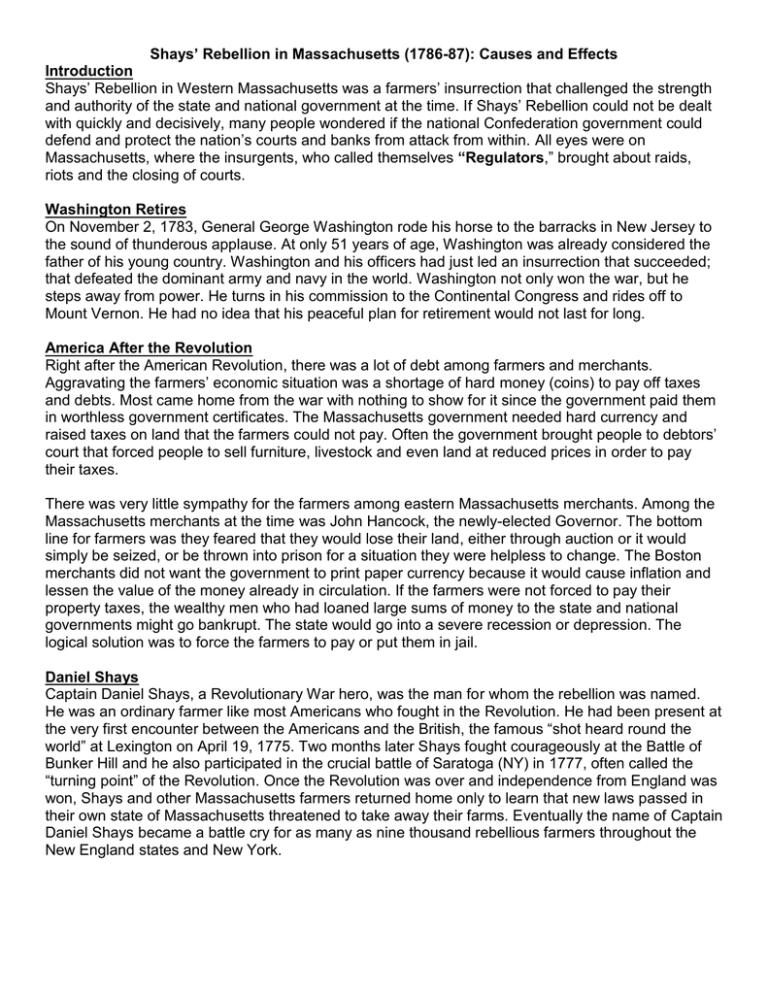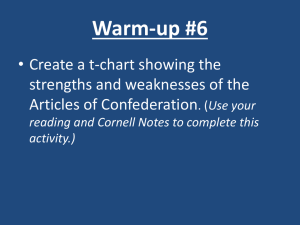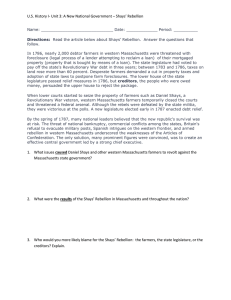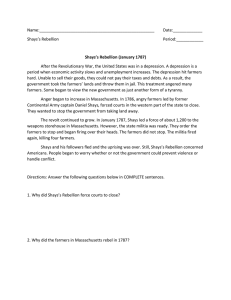The Events of Shays' Rebellion
advertisement

Shays’ Rebellion in Massachusetts (1786-87): Causes and Effects Introduction Shays’ Rebellion in Western Massachusetts was a farmers’ insurrection that challenged the strength and authority of the state and national government at the time. If Shays’ Rebellion could not be dealt with quickly and decisively, many people wondered if the national Confederation government could defend and protect the nation’s courts and banks from attack from within. All eyes were on Massachusetts, where the insurgents, who called themselves “Regulators,” brought about raids, riots and the closing of courts. Washington Retires On November 2, 1783, General George Washington rode his horse to the barracks in New Jersey to the sound of thunderous applause. At only 51 years of age, Washington was already considered the father of his young country. Washington and his officers had just led an insurrection that succeeded; that defeated the dominant army and navy in the world. Washington not only won the war, but he steps away from power. He turns in his commission to the Continental Congress and rides off to Mount Vernon. He had no idea that his peaceful plan for retirement would not last for long. America After the Revolution Right after the American Revolution, there was a lot of debt among farmers and merchants. Aggravating the farmers’ economic situation was a shortage of hard money (coins) to pay off taxes and debts. Most came home from the war with nothing to show for it since the government paid them in worthless government certificates. The Massachusetts government needed hard currency and raised taxes on land that the farmers could not pay. Often the government brought people to debtors’ court that forced people to sell furniture, livestock and even land at reduced prices in order to pay their taxes. There was very little sympathy for the farmers among eastern Massachusetts merchants. Among the Massachusetts merchants at the time was John Hancock, the newly-elected Governor. The bottom line for farmers was they feared that they would lose their land, either through auction or it would simply be seized, or be thrown into prison for a situation they were helpless to change. The Boston merchants did not want the government to print paper currency because it would cause inflation and lessen the value of the money already in circulation. If the farmers were not forced to pay their property taxes, the wealthy men who had loaned large sums of money to the state and national governments might go bankrupt. The state would go into a severe recession or depression. The logical solution was to force the farmers to pay or put them in jail. Daniel Shays Captain Daniel Shays, a Revolutionary War hero, was the man for whom the rebellion was named. He was an ordinary farmer like most Americans who fought in the Revolution. He had been present at the very first encounter between the Americans and the British, the famous “shot heard round the world” at Lexington on April 19, 1775. Two months later Shays fought courageously at the Battle of Bunker Hill and he also participated in the crucial battle of Saratoga (NY) in 1777, often called the “turning point” of the Revolution. Once the Revolution was over and independence from England was won, Shays and other Massachusetts farmers returned home only to learn that new laws passed in their own state of Massachusetts threatened to take away their farms. Eventually the name of Captain Daniel Shays became a battle cry for as many as nine thousand rebellious farmers throughout the New England states and New York. Actions By the Farmers At first, the Massachusetts farmers tried to work within the framework of government and suggested new laws such as the printing of paper currency so that they could pay their taxes with cheaper money. The legislature decided to side with the merchants against the farmers. By the end of summer 1786, the farmers were desperate. They viewed the new government as just another form of tyranny. In August of 1786, a convention of delegates from 50 Massachusetts towns met in Hatfield, Massachusetts. They drew up a petition to the state government protesting the new taxes. State officials replied that the Hatfield Convention was against the law and the delegates were rebels. Many western Massachusetts farmers became convinced that in order to save their farms and their independence, they had to act to close the civil courts that were threatening to take away their land and give it to their creditors. If the courts could not meet, the judges could not rule in favor of the merchants or creditors and the farmers would keep their land, at least temporarily. During the autumn of 1786, Revolutionary army veterans like Shays organized groups of armed farmers into squads and companies in order to march upon the local debtors’ courts and force the courts to stop their business. For a while the state government seemed helpless to do anything about the farmers’ uprising. What Action Was Taken To Stop The Rebellion? Merchants and lawmakers in the eastern part of the state were alarmed. They called on the national Congress of the Confederation government in New York City to call up federal troops to combat the Massachusetts rebels, but the national government could not raise enough money to pay soldiers to go to western Massachusetts. What was to be done to stop the insurgency? Samuel Adams wrote and put into law several new measures in Massachusetts: 1) Militia Act of 1786—If you were in the militia and you rebelled against the government or stopped a court proceeding you could be put to death 2) He suspended habeas corpus—Congress could take anyone and imprison them at will without a trial 3) Riot Act of 1786—If more than 12 people got together for any purpose that the government construed as negative, they could jail them, take away their property and try them for treason The Events of Shays’ Rebellion The final battle of the rebellion was Shays’ attack on the federal arsenal at Springfield in January 1787. The capture of guns and ammunition were necessary for the rebels in order for them to be able to hold off the state troops who were advancing from Boston under the command of General Benjamin Lincoln. As Shays and his men advanced on the Springfield arsenal, the local militia, commanded by General William Shepard, suddenly and unexpectedly fired their cannons, killing four and wounding twenty. Shays’ men, confused and angry, quickly retreated, crying “Murder!” They never expected their own countrymen and fellow soldiers to fire on them. For the next several months into 1787, there were a number of isolated armed confrontations, but the back of the rebellion was broken. Shays escaped to Vermont, followed by several others of his men. What Happened To The Rebels? The Shays farmer-soldiers never imagined their actions in defense of their land and property would lead to charges of “treason” against the government. Just the opposite was the case. Once Shays’ Rebellion was over, the Massachusetts’ courts brought over 200 rebels to trial. In April 1787, five Shays men charged with treason were condemned to hang. The new Governor, John Hancock, wanted to send a message to future rebels, but did not wish to further divide the state. General Lincoln, who had defeated the rebellion, asked the Governor to pardon the men. Hancock’s solution: In order to show the justice and mercy of government, the five guilty men were marched to the gallows on June 21, 1787. As the large crowd watched and waited, they cheered as the rebels were issued pardons by the Governor at the very last minute. The government gave Daniel Shays a full pardon in 1788; as were all the other members of the rebellion and allowed to return to their homes. Epilogue: Massachusetts After The Rebellion In May, the newly elected Massachusetts legislature acted quickly to reduce land taxes and suspend all debts. In a show of mercy and healing, they acted to pardon the rebel farmers. The year after the rebellion was ended, economic prosperity returned to the state of Massachusetts and the lives of farmers, along with most ordinary citizens began to improve. Shays’ Rebellion frightened many national leaders. They worried that the new government could not control unrest and prevent violence. Some leaders believed that a strong national government was the solution to America’s problems. They demanded a reform of the Articles of Confederation. Two Americans who were active in this change were James Madison and Alexander Hamilton. At first, George Washington was not enthusiastic about the movement to revise the A of C, but when he heard the news about Shays’ Rebellion, he changed his mind, coming out of retirement, and agreed to attend the Philadelphia convention.







